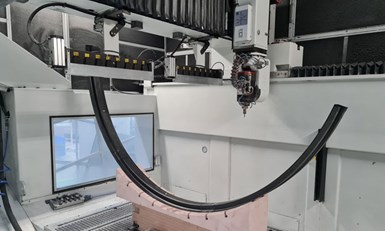CAMX 2022 exhibit preview: Collins Aerospace
Collins Aerospace identifies its extensive thermoplastics portfolio, including the display of an aircraft nacelle’s integrated curved stiffener and upper and lower longerons.

Integrated curved stiffener. Photo Credit: Collins Aerospace
Collins Aerospace (Charlotte, N.C., U.S.) specializes in technologically advanced, intelligent solutions that seek to redefine the aerospace and defense industry. The company dedicates its capabilities, comprehensive portfolio and expertise to solving customers’ toughest challenges and meeting the demands of the global market. Customers include aircraft and engine manufacturers, airlines, business aviation owners and operators, urban air mobility (UAM) and beyond.
Thermoplastic and thermoset composite technologies are one way in which Collins Aerospace is creating solutions for complex, lightweight structures that are safer, more efficient, more sustainable and lower in cost to manufacture. Moreover, the company is identifying how thermoplastics can improve products used in space exploration and defense applications.
On display at this year’s show is an integrated curved stiffener as well as upper and lower longerons, all commonly positioned on a large fan cowl of an aircraft nacelle. Collins’ thermoplastic portfolio ranges from wing and fuselage clips and brackets to large nacelle thermoplastic structural assemblies — wing and fuselage detail parts, nacelle structures, doors and flight control surfaces.
Using a combination of materials, manufacturing processes and expertise, integrated thermoplastic composites — like access doors, engine nacelles, flight control surfaces and interiors — are said to be lighter in weight and more affordable due to their distinctive welding capabilities, which minimizes and even eliminates the need for fasteners. These aerospace composite structures can also be manufactured and installed on aircraft where traditional thermosets cannot be present due to the higher temperature properties and durability that are characteristic of thermoplastics.
When it comes to manufacturing more complex products, customers can benefit by as much as an 80% reduction in manufacturing cycle time and a 50% reduction in part weight compared to similar products produced using metallics, according to the company.
Collins Aerospace has a thermoplastic composite manufacturing and customer collaboration centers across Europe and the U.S. All of its thermoplastic composite manufacturing is retained in-house including:
- Modeling for thermoforming
- Tape slitting
- Automated tape laying
- Consolidation by CCM and shuttle press
- Stamp forming
- Automated fiber placement (AFP)
- Assembly by welding
- High-temperature ovens
- Dimensional and nondestructive inspection (NDI)
- Edge seal, primer, painting
- Test services
- Internally qualified processes and material systems
Additionally, the company claims that it has one of the largest and most advanced filament winding production lines in Europe, with the capacity of producing more than 100,000 thermoset components annually.
Each year, Collins Aerospace invest millions of dollars to support aerospace composites and production automation. It also boasts extensive partnerships with well-known universities, associations and consortiums that specialize in thermoplastic composites, robotics and manufacturing.
Related Content
-
Manufacturing the MFFD thermoplastic composite fuselage
Demonstrator’s upper, lower shells and assembly prove materials and new processes for lighter, cheaper and more sustainable high-rate future aircraft.
-
PEEK vs. PEKK vs. PAEK and continuous compression molding
Suppliers of thermoplastics and carbon fiber chime in regarding PEEK vs. PEKK, and now PAEK, as well as in-situ consolidation — the supply chain for thermoplastic tape composites continues to evolve.
-
Plant tour: Joby Aviation, Marina, Calif., U.S.
As the advanced air mobility market begins to take shape, market leader Joby Aviation works to industrialize composites manufacturing for its first-generation, composites-intensive, all-electric air taxi.
















